Two 316 stainless steel expansion joints that leaked during service in an emulsifier plant were examined. The two joints were located up- and downstream of a glass-lined reactor that was cycling a process stream containing lubricant additive precursors, and operating at 7 psig, between ambient temperature and 400°F. The objective of the lab analysis was to locate and determine the cause of the leak in the expansion joints. Visual examination, metallography, SEM microscopy, EDS analysis, and OES chemical analysis were performed. The results indicated that the expansion bellows cracked from chloride stress corrosion cracking that originated on the inside surface.
Chloride contamination within the process stream, steam cleanout and exposure to chloride-containing environments during shutdown likely subjected the expansion bellows to aqueous chloride solutions. Residual stresses from cold working also contributed to the damage mechanism.
By Sudhakar Mahajanam, Vibha Zaman, MISTRAS Group, Inc., and German Ramos, The Lubrizol Corp
Background
Austenitic stainless steels have been the most popular corrosion-resistant materials for a wide variety of applications, with the 300 series being the largest category of stainless steels (SS) produced in the US.1 However, in the presence of aqueous chlorides, tensile stress and temperatures above 140°F, chloride stress corrosion cracking (Cl–SCC) of 300 series SSs can occur.2 Dissolved oxygen in the process stream can exacerbate this cracking.
In this case study, failure analysis was performed on two 316 stainless steel expansion joints that were retrieved from a unit reactor circulating a process fluid containing lubricant additive precursors. The system operated as a batch process, with cyclical temperatures ranging from ambient to maximum operating temperatures of 400°F. The operating pressure was 7 psig.
The site also reported that the possibility of chlorides in the system could not be ruled out. The two joints were in operation for 10 months, followed by a 1-month shutdown during which they were subjected to steam cleaning.
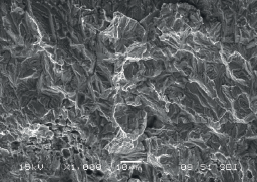

The leaks were found upon resumption of operations. One joint was located upstream of the reactor tank, while the other joint was located downstream of the reactor, on the suction side. The reactor tank was glass-lined and worked in tandem with a similar reactor vessel circulating the same process stream. The purpose of the expansion joints was to reduce the stresses experienced by the glass-lined nozzles in the unit. The tanks were part of a chemical plant manufacturing emulsifiers. A photograph of the leaking upstream expansion joint taken onsite is shown in Figure 1. Both the upstream and downstream expansion joints were examined in the laboratory to determine the damage mechanism(s) responsible and the differences, if any, between the two failures.
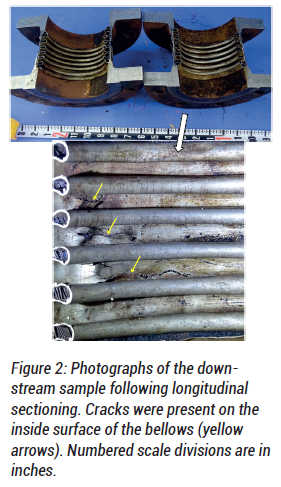
Laboratory Examination
Visual Examination
Dimensional measurements of the two samples indicated that the upstream expansion joint was of 4-inch diameter, 8¾-inch height, and the downstream expansion joint was of 4-inch diameter, 5¾-inch height. The expansion joints contained a braided-hose style wire mesh that encased a bellows region, with flanges present on either end as observed in the longitudinal section of the downstream sample shown in Figure 2. The close-up photograph of the inside surface of the bellows indicated the presence of cracks (marked by yellow arrows). Similar cracks were observed for the upstream sample as well. The upstream flanges were of the floating type, and the downstream flanges were of the welded type.
The cracks were opened using lab overload so that the fracture surfaces could be examined using a stereo microscope. Figure 3 shows a photograph and a stereomicrograph of the fracture surface for the downstream sample.
The fracture morphology appeared to be transgranular. Similar crack morphology was observed for the upstream bellows sample.
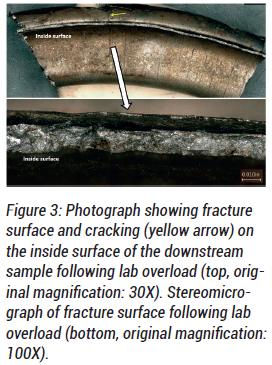

Scanning Electron Microscopy (SEM) and Energy Dispersive X-Ray Spectroscopy (EDS)
SEM fractography of the two bellows samples was also performed following ultrasonic cleaning. The fracture morphology was transgranular, with the cracking occurring by a cleavage mechanism. Figure 4 shows SEM images for the downstream bellows sample. Similar images were obtained for the upstream bellows sample.
Prior to ultrasonic cleaning, EDS analysis was performed to document the elements present within the deposits/corrosion products on the two fracture surfaces. Standardless EDS analysis does not accurately measure carbon contents; hence, these values were excluded from analysis. The upstream bellows fracture surface primarily consisted of iron, oxygen and chromium with several trace elements including chlorine as shown in Figure 5. The downstream bellows fracture surface primarily consisted of iron, oxygen, chromium, nickel with several trace elements including sodium and chlorine.
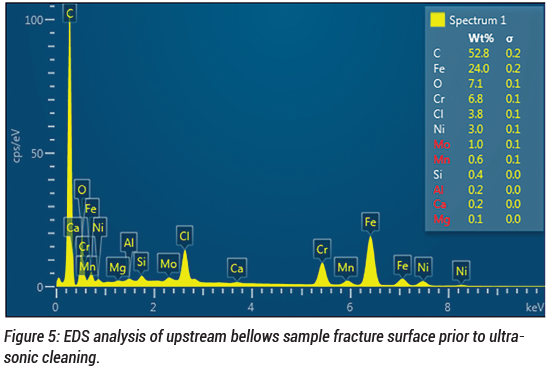
Metallographic Examination
Two metallographic mounts were prepared using sections of the downstream and upstream bellows samples. Figure 6 shows a photograph of a representative mount. Optical micrographs for the upstream bellows cross-section are shown in Figure 7. Similar micrographs were taken for the downstream bellows sample. For both samples, the crack morphology was distinctly transgranular with the craze-cracked, lightning bolt appearance. The cracks displayed multiple branching and originated from the inside surface of the bellows. The general microstructure of the bellows material consisted of austenite grains along with bands of residual ferrite, which are typical of formed stainless steels.

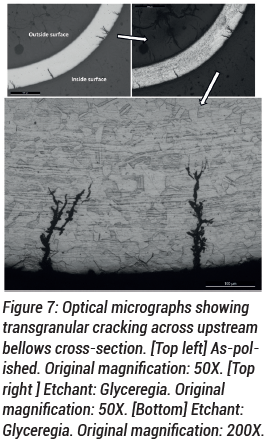
Chemical Analysis
To confirm the material of construction of the two bellows samples, optical emission spectroscopy (OES) was performed to determine their chemical compositions. The results provided in Table 1 indicate that the two samples met the compositional requirements for UNS S31600 austenitic SS.

Conclusions and Recommendations
Based on the results of the laboratory examination of the two expansion joints, it is evident that the inside surface of the bellows cracked from chloride-induced stress corrosion cracking (Cl–-SCC). The fracture morphology was distinctly transgranular with branched cracking occurring in cleavage mode. EDS analysis of the fracture surfaces confirmed the presence of chlorides, which are known to promote Cl–-SCC. Any chloride contamination within the process stream, the steam cleanout and the exposure to chloride-containing environments during shutdown may have subjected the inside surfaces of the bellows to aqueous chloride solutions. Residual stresses present in cold worked components, such as these expansion bellows, are also known to contribute to the damage mechanism.
Another consideration was the similarity in crack morphologies for Cl–-SCC and caustic SCC. Although sodium was also found on the downstream bellows fracture surface, the possibility of caustic SCC was ruled out because the fracture surface did not contain a black magnetite oxide layer, typically found in caustic SCC failures.
The two expansion bellows met the compositional requirements for UNS S31600 austenitic stainless steel. The general microstructure of the bellows material consisted of austenite grains along with bands of residual ferrite, which are typical of formed austenitic stainless steels.
One way to mitigate against Cl–-SCC is to avoid conditions where chlorides can concentrate or deposit onto the 316 SS surfaces. From the perspective of manufacturing, a stress relief heat treatment of expansion bellows following fabrication can reduce residual stresses. However, care should be taken to avoid sensitization of the 316 SS, which can then lead to intergranular corrosion/cracking. Upgrading to higher nickel base alloys, such as Inconel, can provide increased Cl–-SCC resistance.

